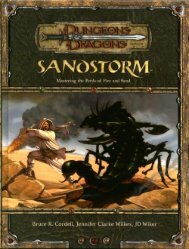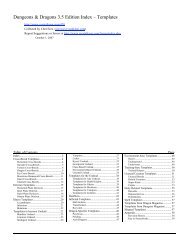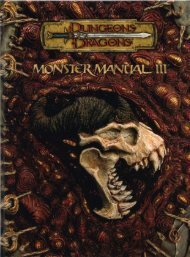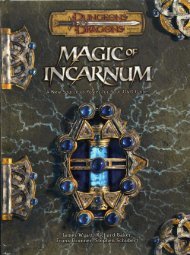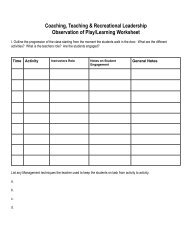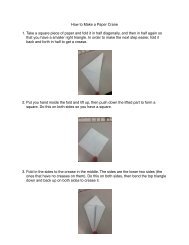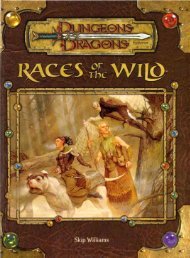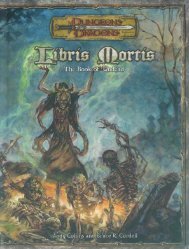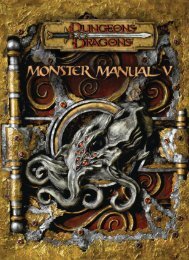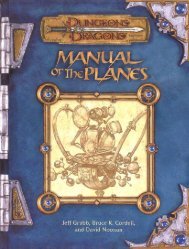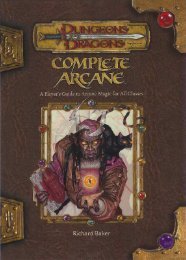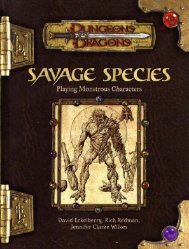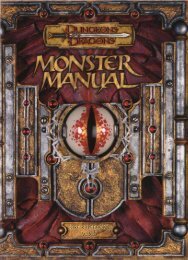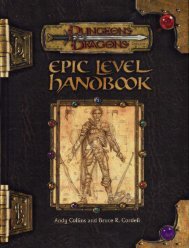Exemplars of Evil
Exemplars of Evil
Exemplars of Evil
You also want an ePaper? Increase the reach of your titles
YUMPU automatically turns print PDFs into web optimized ePapers that Google loves.
CHAPTER 1<br />
GREAT<br />
VILLAINS<br />
14<br />
Lust<br />
A villain motivated by lust covets something and is driven to<br />
distraction by her desire to acquire it. Lust <strong>of</strong>ten implies a physical<br />
attraction to another being, but it also includes base greed.<br />
Example (Immortality): Believing that elves hold the<br />
secret <strong>of</strong> eternal life, a power-mad warlord musters his armies<br />
to conquer the natives <strong>of</strong> an ancient sylvan forest so that he<br />
can graft their flesh to his own.<br />
Madness<br />
Insanity allows villains to pursue the most unlikely goals<br />
and commit the most horrific atrocities. A villain driven<br />
by madness might have delusions about the outcome <strong>of</strong> his<br />
objective, or perhaps he works toward the goal for no particular<br />
reason at all.<br />
Example (Immortality): A disturbed beholder captures<br />
and petrifies halflings so that he can memorialize<br />
them forever.<br />
Order<br />
In the face <strong>of</strong> terrifying monsters, ambitious criminals,<br />
and countless other calamities, some believe that the only<br />
solution is to impose absolute order. These villains try to<br />
force their views on others because they are convinced that<br />
they are right.<br />
Example (Recognition): To prove the necessity <strong>of</strong> order, a<br />
cleric <strong>of</strong> St. Cuthbert secretly provokes a tribe <strong>of</strong> hobgoblins<br />
into attacking his city. When the citizens start to panic, the<br />
priest emerges as a leader, arguing that only his draconian<br />
policies can protect the people from the invading monsters.<br />
THE VILLAIN’S PLOT<br />
With your villain’s objective and motivation in place, it’s time<br />
to hatch the details <strong>of</strong> his plan. At this point, you might not<br />
have developed any statistics for the villain other than his<br />
Challenge Rating and perhaps his race. That’s fine—let his<br />
class, feats, spells, and magic items serve the story, rather<br />
than the other way around.<br />
This section gives you the basic elements for building your<br />
villain’s plot. It is not a crash course on adventure design or<br />
a discussion <strong>of</strong> the merits and flaws <strong>of</strong> linear adventures.<br />
Instead, these guidelines are intended to help you organize<br />
your thoughts when creating scenarios and villains. It is up<br />
to you to fill in the blanks.<br />
SPECIFYING THE GOAL<br />
Your villain has an objective and a motivation. Now, use them<br />
to determine exactly what he hopes to achieve. Be specific: If<br />
the villain wants immortality, choose the precise form—will<br />
he become a lich, seek a place in the court <strong>of</strong> Asmodeus,<br />
extend his natural life, become a deity, or pursue some other<br />
strategy? Remember to consider his motives, which will<br />
guide you through the many options and help you settle on<br />
the perfect choice.<br />
CONSEQUENCES<br />
Before delving into the specific steps <strong>of</strong> the villain’s plan,<br />
decide what is at stake if the PCs fail to stop her. The potential<br />
consequences will compel them to become involved in the<br />
first place and will ensure that they continue to fight the<br />
villain throughout the adventure or campaign. The possible<br />
outcome should be significant enough to pose a real danger to<br />
the world; it might even threaten the setting’s very existence.<br />
Consequences that dramatically alter a setting can serve as the<br />
basis for future campaigns, giving you the ability to start over<br />
with new heroes striving to right the wrongs <strong>of</strong> the old.<br />
SCHEME<br />
At last, it is time to map out the villain’s scheme and choose<br />
the steps he will take to reach his objective. As you flesh out the<br />
details, keep in mind the basic components <strong>of</strong> great villains. The<br />
plot <strong>of</strong> a one-shot villain should have relatively few steps, since<br />
the character will not survive long enough to reach his ultimate<br />
goal. A recurring villain’s scheme can be more complex. As a<br />
rule <strong>of</strong> thumb, a one-shot villain should be able to attain his<br />
goal in the space <strong>of</strong> a single adventure, but a recurring villain<br />
might not reach his goal until the end <strong>of</strong> the campaign.<br />
One way to design the villain’s scheme is to work backward.<br />
State the goal as if the villain had already achieved it, and<br />
then, moving in reverse, write down each step that he took<br />
to reach that point. In the process, you might come up with<br />
several different ways for the villain to achieve his objective.<br />
For now, choose one path and keep the others in reserve. If<br />
the PCs thwart the villain in the early stages <strong>of</strong> his scheme,<br />
you can switch to one <strong>of</strong> the other plans.<br />
RESOURCES<br />
With the scheme mapped out, you are ready to outfit your villain<br />
with the appropriate materials. His resources might include<br />
minions and lackeys, magical power, political influence, a<br />
particular class or prestige class, a feat, ranks in a specific skill,<br />
or a magic item. Make a list <strong>of</strong> everything that the villain should<br />
have. These resources become the building blocks for creating<br />
the villain’s statistics and forming his organization.<br />
When the list is finished, set it aside for now. Later, when<br />
you generate the villain’s statistics, return to the list and use<br />
it to guide your decisions.<br />
ADVANCING THE PLOT<br />
The trickiest part about running a great villain is advancing<br />
his plot. Over the course <strong>of</strong> a campaign, the player characters<br />
should have plenty <strong>of</strong> chances to ruin the villain’s plans. Their<br />
successes can spell the villain’s doom or just set him back<br />
temporarily, forcing him to find another path to his goal.<br />
The objectives <strong>of</strong> one-shot villains are immediate, so you<br />
might assume that the villain has been working toward his<br />
objective in the background the whole time. When the PCs<br />
come onto the scene, they can stop the villain at a crucial<br />
moment and put an end to his scheme.<br />
Recurring villains require a bit more finesse. From the<br />
moment you introduce one into your game, he is working<br />
toward his goal. Even when the PCs are busy elsewhere, the<br />
villain keeps advancing his plots; the trick lies in gauging<br />
his progress behind the scenes.<br />
The Encounter Level <strong>of</strong> encounters in the lowest or starting<br />
plot element should be 1 or 2 lower than the party level,<br />
while the EL <strong>of</strong> encounters involving the climactic plot<br />
element should be commensurate with the highest level you<br />
expect the characters to attain while the villain is active in<br />
the campaign. As the average party level rises, so too does<br />
the villain make progress toward his goal.



